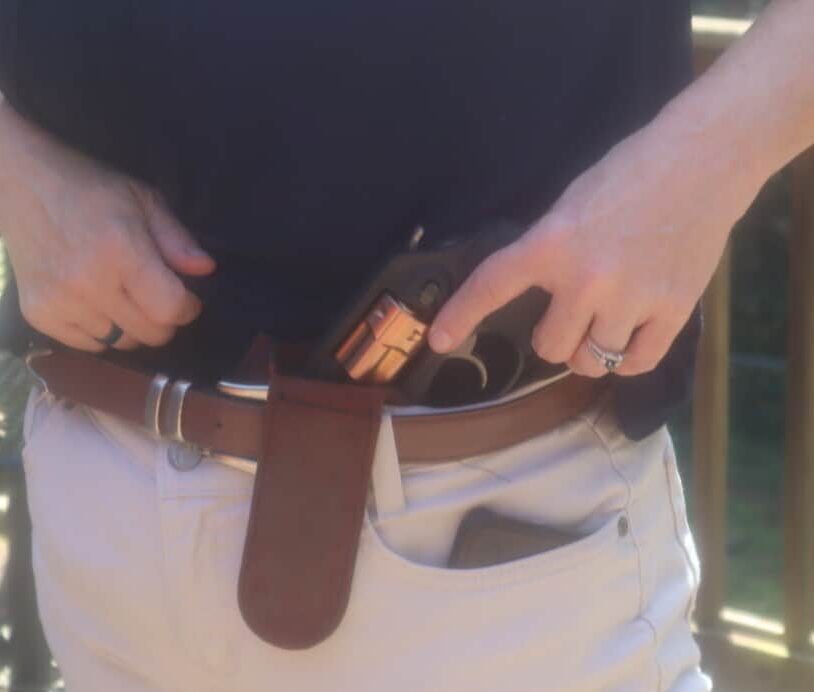When you start carrying a concealed weapon, you are making a significant adjustment to your lifestyle. You now have at your fingertips the ability to save a life–or end one. The stakes are bigger now, and the mistakes more costly.
Errors range from the silly to the deadly. Your goal is to be armed without calling attention to yourself or violating any rules. Here are 10 big pitfalls to avoid, listed in reverse order of magnitude.
- Overdoing the tactical wear
- Expecting trouble around every corner
- Constantly adjusting your clothing
- Micromanaging your holster placement
- Patting yourself down to see if the gun is still there
- Printing
- Forgetting extra ammunition
- Neglecting to carry your weapon
- Showing your firearm
- Ignoring the law
Tactical Everything
Yes, you look great in your camouflage hat and your tactical pants, but don’t wear all your tactical clothing at once. If you look like you are about to go on safari, you will draw attention to yourself.
Standard clothing will work just fine. Prints, dark colors, roomy fit, and sturdy fabrics conceal better than obvious military-type gear because they don’t draw attention.
The point is to avoid standing out.
Expecting Trouble
You’ve seen people who fairly vibrate with suspicion, jumping at every noise and peering around every corner. Don’t do a Barney Fife impression. The world may in fact be out to get you, but it’s more likely that no one is even paying attention to you.
Be alert but don’t be paranoid.
I was on hyper alert when I first started carrying concealed. Then I realized that life was going on just as it always had. No one suspected or was particularly interested in whether I had a gun.
Adjusting Your Clothing
Concealed carry takes some getting used to, and you do have to pay attention to the way your clothes fold around your gun, but once you have everything situated you need to stop messing with your outfit.
Nothing calls attention to a thing you are trying to hide like squirming constantly and adjusting all the details. You will look like you are wearing your underwear too tight.
Fiddling With Your Holster
Pick a location for your holster, check it before you leave the house, and then leave it alone. You have a bulge under your belt, or wherever you have located your holster. Draw attention away from it by ignoring it.
Most gun owners go through several holster purchases before they find one that suits their needs.
Checking the Gun
The time to check the gun is before you leave home. Walk around in your house with the holster on and practice such maneuvers as bending over and kneeling down to ensure that varying postures don’t apply pressure in a way that squeezes your gun out of its hiding place.
Now that you know it is secure, leave it alone! Unless you feel it wiggling out of its holster, keep your hands off your gun when you are out in public. If you must adjust, find the bathroom and take care of it in private.
Printing
Invest in a mirror that allows you to see yourself from the back and the side. Check all the angles, especially if you carry your gun tucked behind you at the waistband. A jacket is great cover, but don’t let the gun cause the tail of the jacket to stick straight out behind you.
Light colors, thin fabrics, tight fit, and a large weapon conspire together to show what you think you are hiding. Most people won’t notice, but someone with a military or police background will spot you quickly.
This could lead to an awkward conversation or worse. In the case of an actual threat, the assailant will take you out first to eliminate the chance of resistance.
Forgetting to Bring Extra Ammunition
I hope you never have to use your gun to defend yourself. If you do, I hope you stop the attacker in one shot.
If your aim is off or the assailant is hopped up on drugs or adrenalin, you might need extra shots to stop the threat. Villains tend to run in groups, so you may be fending off multiple attackers.
An extra magazine doesn’t take up much room. They even make holsters that just carry a magazine or two and there’s a pretty good chance there’s one made just for your model of gun.
Leaving the Gun at Home
If you ask my husband Chris what weapon is best for concealed carry, he will give you the same answer every time: “The best weapon is the one you will carry.” If it’s too big or has too much recoil you won’t enjoy practicing with it and you won’t carry it consistently.
Find a gun you like and carry it everywhere you are legally entitled to carry.
Showing Your Weapon
Accidentally showing your weapon can get you in big trouble. In South Carolina allowing someone to see your gun is called “brandishing” and is prosecutable. Check the mirror while you stretch and bend in all directions before you finalize your outfit for the day.
Ignoring the Law
Each state has its own laws concerning concealed carry, and you need to know the law before you strap on your gun and walk into any establishment. If you enter a properly posted business with a gun on, you have violated the law.
It takes multiple errors to get caught with a weapon where it is not allowed. You have to ignore the law and someone has to realize you are armed. That person then has to be concerned enough to draw attention to your error.
Nevertheless, you don’t want to leave yourself open to prosecution. Just leave the gun in your car where it is legal to do so, or make the outing without your gun if you have to.
I personally avoid gun free zones when possible, but it isn’t easy to avoid schools, post offices, and medical buildings all the time.
How To Learn More
Knowledge is key, and you want to learn the easy way, with a friendly instructor, rather than because life taught you a lesson.
Get your concealed weapons permit. In some states it is mandatory, but it’s a good idea even in a Constitutional Carry states because it allows reciprocity between states.
Ask a knowledgeable friend to give you pointers and take that friend to the shooting range with you. Gun enthusiasts love to talk about their hobby.
Go to your local gun store and ask for the name of a local instructor, or go online. Your state’s regulatory body will have a list of licensed instructors in your area.


